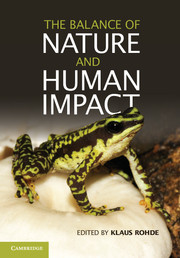Book contents
- Frontmatter
- Contents
- Foreword
- List of contributors
- Acknowledgments
- Introduction
- Part I Nonequilibrium and Equilibrium in Populations and Metapopulations
- Part II Nonequilibrium and Equilibrium in Communities
- Part III Equilibrium and Nonequilibrium on Geographical Scales
- Part IV Latitudinal Gradients
- Part V Effects Due to Invading Species, Habitat Loss and Climate Change
- 13 The physics of climate: equilibrium, disequilibrium and chaos
- 14 Episodic processes, invasion and faunal mosaics in evolutionary and ecological time
- 15 The emerging infectious diseases crisis and pathogen pollution
- 16 Establishment or vanishing: fate of an invasive species based on mathematical models
- 17 Anthropogenic footprints on biodiversity
- 18 Worldwide decline and extinction of amphibians
- 19 Climatic change and reptiles
- 20 Equilibrium and nonequilibrium in Australian bird communities – the impact of natural and anthropogenic effects
- 21 Population dynamics of insects: impacts of a changing climate
- 22 The futures of coral reefs
- Part VI Autecological Studies
- Part VII An Overall View
- Index
- References
18 - Worldwide decline and extinction of amphibians
from Part V - Effects Due to Invading Species, Habitat Loss and Climate Change
Published online by Cambridge University Press: 05 March 2013
- Frontmatter
- Contents
- Foreword
- List of contributors
- Acknowledgments
- Introduction
- Part I Nonequilibrium and Equilibrium in Populations and Metapopulations
- Part II Nonequilibrium and Equilibrium in Communities
- Part III Equilibrium and Nonequilibrium on Geographical Scales
- Part IV Latitudinal Gradients
- Part V Effects Due to Invading Species, Habitat Loss and Climate Change
- 13 The physics of climate: equilibrium, disequilibrium and chaos
- 14 Episodic processes, invasion and faunal mosaics in evolutionary and ecological time
- 15 The emerging infectious diseases crisis and pathogen pollution
- 16 Establishment or vanishing: fate of an invasive species based on mathematical models
- 17 Anthropogenic footprints on biodiversity
- 18 Worldwide decline and extinction of amphibians
- 19 Climatic change and reptiles
- 20 Equilibrium and nonequilibrium in Australian bird communities – the impact of natural and anthropogenic effects
- 21 Population dynamics of insects: impacts of a changing climate
- 22 The futures of coral reefs
- Part VI Autecological Studies
- Part VII An Overall View
- Index
- References
Summary
Amphibians constitute the most threatened major taxon on Earth today. Their dependence on cutaneous respiration necessitates a thin, moist, permeable skin that makes them vulnerable to desiccation, toxic chemicals, endocrine disruptors and changes in their physical environment. The seasonal migration of many species between terrestrial habitats and aquatic breeding sites exposes them to hazards such as increased risk of predation, traversing of inhospitable habitats and automobile traffic. Invasive species and destruction and fragmentation of habitat are implicated in some declines and humans collect amphibians for food, pets, research and medicines. Although amphibians cutaneously secrete a wide variety of antibiotics (Erspamer, 1994), they are susceptible to some viral, bacterial, parasitic and fungal infections. Thus, the alarming rate of decline and extinction of amphibians globally is not caused by a single agent (Halliday, 2005), but by a suite of them that vary geographically (Stuart et al., 2010), and interact with each other. Changes in global climate have exacted a toll on amphibians already and are projected to be increasingly severe in the future. The present chapter reviews the causes of global decline and extinction of amphibians around the world. The reasons vary from one place to another.
History of amphibian decline
Following a growing, but mainly anecdotally based, awareness among herpetologists during the 1970s and 1980s that many amphibian populations were declining, special sessions to discuss the phenomenon began to be held at meetings of scientific societies, notably one by the United States Academy of Sciences in February 1990 that concluded that declines should be treated as a possible emergency and that recommended a body be established to determine the extent of the problem. The resulting agency was the Declining Amphibian Populations Task Force (DAPTF), set up in December 1990 under the umbrella of the Species Survival Commission (SSC) of the International Union for the Conservation of Nature (IUCN). It is now the IUCN/SSC Amphibian Specialist Group (ASG).
- Type
- Chapter
- Information
- The Balance of Nature and Human Impact , pp. 259 - 278Publisher: Cambridge University PressPrint publication year: 2013
References
- 6
- Cited by

